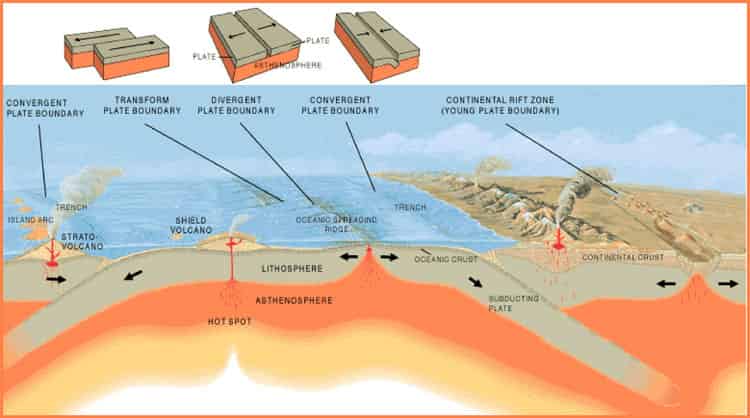Crust Destroyed Is Goes Best With Which Plate Boundary
Transform plate boundaries also known as conservative plate boundaries occur where lithospheric plates slide past each other and where the crust is neither destroyed nor formed. The San Andreas Fault is responsible for most of the movement in western California causing a sliver of the.

Plate Tectonics Earth S Changing Face
Tap again to see term.
. The first sort of plate boundary is called a divergent boundary or spreading center. Click card to see definition. The new crust is destroyed during diverging of plates because the magma is flowing out melting its materials.
Just as oceanic crust is formed at mid-ocean ridges it is destroyed in subduction zones. This is an earthquake. Explore these boundaries the theory of plate tectonics and how convection currents cause the Earths.
View the full answer. At convergent plate boundaries oceanic crust is often forced down into the mantle where it begins to melt. What type of plate is plate a what about plate B.
Each of these types of plate boundaries is associated with different geological features. New crust is created due to seafloor spreading. It is because plate A or the oceanic plate is thinner than plate B which is continental plate.
A constructive plate boundary sometimes called a divergent plate margin occurs when plates move apart. Where does the new crust come from where does the old crust go. Subduction zones occur when one or both of the tectonic plates are composed of oceanic crust.
Typically a convergent plate boundarysuch as the one between the Indian Plate and the Eurasian Plateforms towering mountain ranges like the Himalaya as Earths crust is crumpled and pushed upward. Answer which plate boundary ies the feature goes best with. All the old oceanic crust is going into these systems as new crust is formed at the spreading centers.
There are three main types of plate boundaries. Where two plates are colliding. Thus at convergent boundaries continental crust is created and oceanic crust is destroyed.
These plate boundaries are commonly associated with and evolve as a consequence of the accommodation of displacement along spreading ridges. Tap card to see definition. Where crust is neither produced nor destroyed as the plates slide horizontally past each other.
In some cases however a convergent plate boundary can result. Which BEST describes the divergent plate boundary. When the plates spread magma is forced through the cracks and cools forming new land.
Divergent boundaries where new crust is generated as the plates pull away from each other. Subduction is the important geologic process in which a tectonic plate made of dense lithospheric material melts or falls below a plate made of less-dense lithosphere at a. As the two move apart mid-ocean ridges are created as magma from the mantle upwells through a crack in the oceanic crust and cools.
Most seismic activity occurs at three types of plate boundariesdivergent convergent and transform. Click again to see term. As the plates move past each other they sometimes get caught and pressure builds up.
Question 1 Answer which plate boundary ies the feature goes best with 1 shear stress transform о O both divergent and convergent all of the above divergent Ο Ooo convergent Question 2 Answer which plate boundary ies the feature goes best with 2 crust destroyed all of the above both divergent and convergent divergent. The three types of plate boundaries are divergent convergent and transform boundaries. Usually between oceanic and continental plates where subduction of the more dense oceanic crust occurs.
These boundaries are in the form of trench and island arc systems. Volcanoes are formed as magma wells. Question 7 Answer which plate boundaryies the feature goes best with 7 Turkey all of the above O convergent O both divergent and convergent O transform O divergent Question 8 Answer which plate boundaryies the feature goes best with 8 tensional stress a all of the above O divergent transform O convergent both divergent and convergent Question 9.
Subduction is the important geologic process in which a tectonic plate made of dense lithospheric material melts or falls below a plate made of less-dense lithosphere at a convergent plate boundary. The plates in the divergent boundary are moving away from each other. The plate being forced under is eventually melted and destroyed.
Magma rises into and through the other plate solidifying into granite the rock that makes up the continents. At subduction zones where plates meet some crust can be forced underneath other crust causing the destruction of ocean floor. When the plates finally give and slip due to the increased pressure energy is released as seismic waves causing the ground to shake.
At these boundaries two plates move away from one another. Where crust is destroyed as one plate dives under another. The plates in divergent boundary move towards each other.
The denser plate is subducted underneath the less dense plate. Just as oceanic crust is formed at mid-ocean ridges it is destroyed in subduction zones. Convergent boundaries where crust is destroyed as one plate dives under another.
The Pacific Plate slides north-northwestward past the North American Plate along the San Andreas Transform Plate Boundary. Transform boundaries where crust is neither produced nor destroyed as the plates slide horizontally past each other. These are plate margins where one plate is overriding another thereby forcing the other into the mantle beneath it.
Crust is destroyed or recycled at convergent plate boundaries.
Plate Tectonic Theory The British Geographer

What Are The Different Types Of Plate Tectonic Boundaries Geology Page

Plate Tectonics 101 What Happens When Plates Move Toward Each Other Landscapes Revealed
No comments for "Crust Destroyed Is Goes Best With Which Plate Boundary"
Post a Comment